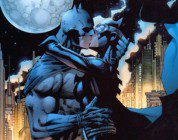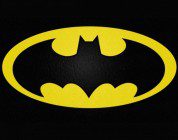They’ve probably been the biggest source of Batman’s newfound popularity with the non-geeky crowd, and there’s a lot going on those films. So in this final article of Batman Month, let’s talk about those themes, the ideas at work behind them, and the comics that inspired the stories. Keep in mind, this is not a review, and there will be spoilers everywhere. You are warned.
The way this is going to work is thus: I’m going to first talk about themes for the whole trilogy, then the themes of the individual films, as well as state what I see as the main comic sources for each one. While I could also spend tons of time talking about how they chose to reinterpret everything to fit the idea of making everything closer to the real world, from the costume to the martial arts, this is a more story-driven article. To quote one memorable villain, “And here, we, GO!”
The Trilogy
The whole trilogy follows the idea of the Hero’s Journey, and there are already plenty of articles out there about it, so I won’t go on too much. If there’s one other theme that persists throughout the trilogy it is one of fear and hope. It’s more pronounced in the first film, but the driving idea of Batman is using fear on those who would use it to oppress the people of Gotham, and become a symbol of hope to inspire the people of Gotham to stand up to the corrupt and evil that would use fear against them. All the villains, from the mobsters like Carmine Falcone, to the major villains like Scarecrow, Ra’s al-Ghul, Bane and the Joker achieve their goals through instilling fear in the people and using it to achieve their ends, whether it be gaining power, destroying the city, or in the case of the most well-known foe just make the world act how he thinks they should. If there’s one comic that is a clear influence on all three, it’s definitely The Long Halloween by Jeph Loeb and Tim Sale. With its focus on Batman as a dark but still very humane character, his relationship with Gordon, the closer sense of realism with how involved the mob is in the story, it is definitely one that director Chris Nolan and writer David S. Goyer returned to constantly.
Batman Begins
I’ve said it before, and I’ll say it again: each film in the trilogy is a different kind of movie. And the first one is the closest that I could say to being a superhero movie. The main point of the plot is Bruce going on this journey to discover who he is, how he can change the world for the better, and then find the means to pursue that goal. Even the choices of villains push this idea. Like Bruce, Scarecrow uses fear to achieve his ends, but it’s mostly for greed and profit, while Ra’s also seeks to save the world from corruption and evil, but sees the only way to do so being destroying the falling society instead of fixing it from the inside, lacking Bruce’s compassion. Every act and character exists to influence Bruce on this journey, either by his acceptance or refusal of what is in front of him. Rachel challenges him to really face the problems that took his parents’ lives not with vengeance against their killer, but going against the criminal world and corrupt system that creates people like that. Ra’s wants him to kill, something Bruce realizes he could never do even against evil. Every moment is built to help explain why Bruce chose his path, his methods. In the end, Begins is about how a scared lost boy grows into a man who can change the world.
Comic-wise, besides the aforementioned Long Halloween, another clear influence was Year One, which not only contributed to the look of the film, but the relationship between Bruce Wayne and Gordon, a relationship that would be a measure of how the continuing saga would change and develop through the other films.
The Dark Knight
If Begins was a straight-up superhero film, then this one is a crime thriller. It fits as we watch good people clash with a devilishly evil genius who causes death and fear wherever he goes. A lot of people think that Joker’s speech about chaos means that the movie is about order vs chaos. I disagree, primarily because the entire movie is watching Joker’s plans outdo everyone else’s. He has a plan, even if it causes chaos and destruction, which means that his whole “I don’t believe in plans” line to Harvey Dent is a lie, like nearly all the things he says. Which is a lot like the Devil, one of the greatest symbols for evil. And that’s what the theme really is, essentially good versus evil. Joker’s whole purpose in the movie is to tear down the ideals that we hold ourselves to, because he doesn’t believe in them. He has no empathy, no humanity left in him. He seeks to make the world as disturbed as he is, and all his plans are to corrupt everyone else. He wants Batman to break his one rule and kill him, because it’ll mean that he could make a good man turn on his morals. His greatest victory in the movie is corrupting Harvey Dent, finally breaking a good man, and his greatest failure is when his attempts to get people to blow each other up and he can’t. He sees Batman as his great foe because of how selfless he is, something Joker can’t understand and thinks can easily be destroyed, and I imagine that if he could have appeared after Batman takes the fall for Harvey’s crimes, he would not understand how someone can make such a sacrifice. It’s funny that I use that word, because sacrifice is a big part of Bruce’s journey. In confronting this pure evil, Bruce realizes that the world is not as easy to understand as he thought, and with the loss of Rachel, he realizes that no matter what his crusade would have a cost to achieve the goal of a safe and free Gotham.
Long Halloween is more at play here, especially in the story that Harvey Dent goes through, but there’s also influences from Joker’s first appearance, as well as The Killing Joke and how the villain was portrayed in The Dark Knight Returns.
The Dark Knight Rises
If Begins was a superhero film, and Dark Knight was a thriller, then Rises is an epic, with its massive cast of characters that all have major roles in the plot. The main theme is about pain, and finding the reason to live when we think the pain is too much. Both Bruce and Gordon are feeling this pain, with the former stuck in a state of mourning for his lost love Rachel, and Gordon feeling the guilt and anger for letting Batman take the blame for Dent’s crimes, and having to talk about how good Harvey was when he was the man who tried to kill Gordon’s family. Bane represents the ultimate idea of pain for Batman, being a fellow student of Ra’s al-Ghul (representing an old evil that he thought was vanquished) and being something that the downtrodden hero can’t beat in his mental state. The main thing that Bruce finally accepts is that like his fear in the beginning, his pain can be something that can make him stronger. And like our hero, Gotham itself finally achieves this. After two movies of either just accepting the crime and corruption around them, standing up to it when Batman was with them but turning on him after the Joker’s rampage, and being complacent for letting the city still be corrupt even if crime was down, the people (represented brilliantly by the cop John Blake) are willing to stand up with Batman against the evil that they face this time. And when Bruce (now willing to live despite his losses) finally can step down, it’s because he managed to make his dream for Gotham come true. Because like the rest of us, he learns that suffering doesn’t mean we failed to achieve our goals, it’s just as much a part of the journey as the good parts.
Besides the ultimate last Batman story, The Dark Knight Returns, there’s also the influence of Bane’s major story Knightfall (the story of how he managed to strike Batman at his lowest, and the result was him rising back up to glory), as well as No Man’s Land, which really was more an influence on Gotham’s story than it is of Batman’s. The Long Halloween influence here is mostly on Selina Kyle and her flirty romance/partnership with Batman. She represents both the thing that reawakens Bruce’s interest in the world, and the reward he gets at the end when he leaves both Batman and Gotham behind, finally finding the one who can accept all of him.
As always, these are simply my humble opinions on Nolan’s trilogy. There are as many opinions and theories as there are people who watched them, and that’s the greatest thing. Anything that can get you thinking and looking deeper is always a good thing.
With that, Batman Month comes to an end. As always, it was fun digging into my bag of thoughts about this modern mythic character. But don’t worry, there’ll be one next year as well. Until then, bat-fans, take care, and Happy Halloween!



